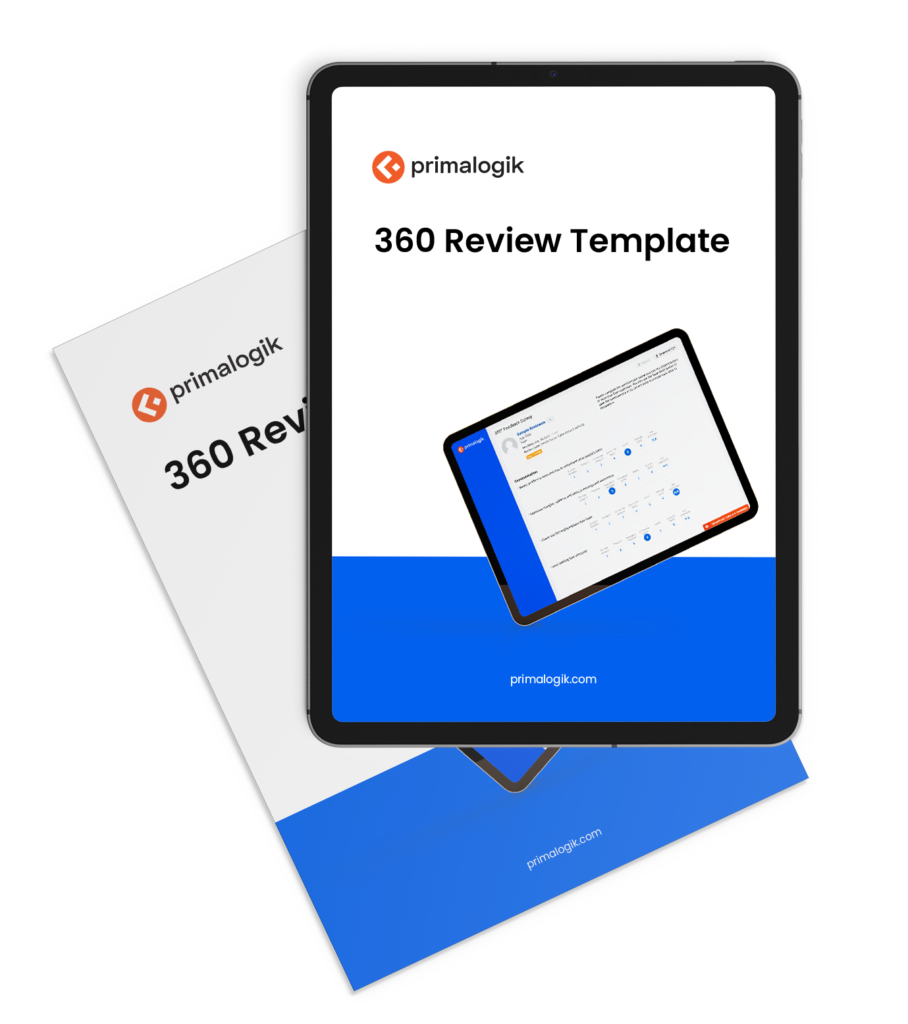360 feedback software is a performance management tool that promotes continuous personal growth. Through this tool, each employee gains insights from a broad spectrum of people. These perspectives can play an instrumental role in career success, while strengthening teams and the company as a whole.
A full 90% of all Fortune 500 companies use 360 feedback surveys. But too many organizations are missing out on the benefits of these valuable tools. In a Gartner survey, only 17% of respondents said that people in their organizations are evaluated by their peers.
Further, not all 360 feedback processes are equally effective. Cutting-edge 360 feedback software brings major advantages over a manual process, as we’ll discuss.
Let’s first examine how 360 feedback software works in practice. Then, we’ll explore its major benefits. After that, we’ll delve into how to implement 360 feedback software and maximize your outcomes.
Table of Contents
1. Understanding 360 Feedback Software
2. Benefits of Using 360 Feedback Software
3. Choosing the Right 360 Feedback Software
4. Best Practices for Maximizing the Impact of 360 Feedback Software
Understanding 360 Feedback Software
The traditional process of gathering 360 feedback requires a lot of legwork. It entails sit-down interviews with numerous participants, as well as data analysis. Plus, it often requires the expense of an outside consultant. In contrast, 360 feedback software eliminates the administrative burden of traditional methods.
Using 360 feedback software tools, organizations can easily collect valuable feedback for each employee. In fact, they can conduct a 360 review for employees multiple times a year. With 360 feedback software, HR no longer has to manually collect and synthesize all that data.
Instead, the system will simply generate findings that managers can discuss with employees. This means that HR and managers can focus on actually coaching employees to success.
Benefits of Using 360 Feedback Software

Investing in 360 feedback software brings numerous benefits. Thoughtful 360-degree feedback provides meaningful insights on how an employee performs. In particular, 360 reviews shine light on a person’s ability to work on a team.
By doing so, 360 feedback software helps individuals take ownership of their own growth. At the same time, it gives their managers a more informed perspective, enhancing their guidance. Let’s explore these benefits of 360 feedback software in depth.
Building Self-Awareness
360 feedback increases self-awareness, as Jack Zenger and Joseph Folkman write in Harvard Business Review. And that greatly increases the likelihood that employees will make positive changes. After all, it’s a lot harder to ignore an issue when you know that others see it.
“People with little self-awareness are often puzzled by the behavior of others toward them,” Zenger and Folkman explain. “They might wonder, ‘Why do people not include me in their casual conversations?’ ‘Why do I end up in heated arguments?’ ‘Why was I not chosen to lead this project? I know more than the person they selected.’”
360 feedback software helps demystify these questions. And employees can benefit immensely from the insights gained through these tools. Instead of worrying and wondering, they can take action to change their behaviour when needed. They’ll better understand what they’re doing well, too.
This self-awareness can help them strengthen their performance in their current job. But it has additional benefits as well. If an employee is considering a new type of role, the feedback can shine light on whether it’s a good fit for them. And if they’re looking toward advancement opportunities, it can determine whether they’re ready.
Have the employee complete a self-evaluation during the 360 review process. This will help reveal any gaps in self-awareness. In turn, self-awareness will immediately begin to grow!
Download Now: Free 360 Reviews Template [Get Your Copy]
Gaining High-ROI Insights
With quality 360 feedback software, employees can shape one another’s development. The ROI of such efforts can be enormous. After all, you’re gaining insights from the people who work most closely with each employee.
Coworkers often understand one another’s strengths and weaknesses better than anyone—sometimes, better than even their manager. Direct reports also have an invaluable perspective, as they understand firsthand how well their boss manages others. This gives you a very cost-efficient yet incredibly effective way of directing people’s growth.
Plus, employees will benefit from hearing diverse perspectives about their aptitudes through 360 feedback software. Different coworkers may have different experiences with them. These insights can illuminate whether they need to hone their performance in specific contexts or overcome biases.
Improving Team Management
Managers will gain a clearer understanding of how employees are performing—and where they need support. In many cases, managers and leaders may not clearly see the interpersonal aspects of performance. They can see an employee’s results, but not how they communicate with colleagues. 360 feedback software provides this vital lens.
Managers can then coach employees on how to work together effectively.
Additionally, managers will better understand the strengths and skill gaps of their whole team. Then, they can work to build any strengths that are lacking.
Strengthening Remote Teams
On remote teams, 360 feedback software is especially critical. Without in-person interactions, people have less clarity on how their colleagues view them. Developing and using strong interpersonal skills proves even more critical to team effectiveness, too.
360 feedback software helps team members intentionally build these skills. Through these tools, they can easily gain and share input from coworkers. This contributes to a culture of sharing constructive feedback.
Creating Change Aligned with Values
An organization can use 360 feedback software to ignite change aligned with its values and strategy, emphasize Allan H. Church and coauthors in Handbook of Strategic 360 Feedback. They’ll learn how to shape the behaviours of leaders, managers, and employees through these tools. Using 360 feedback software boosts accountability for making these changes.
Choosing the Right 360 Feedback Software

Selecting the right 360 feedback software will maximize your ROI from this investment. Choose software that does all of the following:
- Provides a comprehensive list of questions to select from.
- Allows you to customize questionnaires.
- Lets you use both multiple choice and open-ended questions.
- Provides multiple options for rating scales (like 1–3, 1–5, or 1–10).
- Lets participants suggest reviewers.
- Allows for anonymity, if desired.
- Automatically sends reminders to prompt people to complete the survey.
- Lets you track participant rates.
- Allows you to send custom emails explaining the process.
- Synthesizes results for each employee and provides a detailed report.
- Compares results between employees, revealing where strengths and weaknesses lie on your team.
- Tracks results between review cycles, so you can monitor progress.
Additionally, the best 360 feedback software lets you assess managers’ rating styles to ensure fairness—even while preserving anonymity. How does it do this? By showing managers’ median scores rather than the specific results they provided for each employee.
Best Practices for Maximizing the Impact of 360 Feedback Software

After choosing your 360 feedback software, use these strategies to achieve best results. They’ll help you launch, manage, and leverage your feedback successfully.
Implementing 360 Feedback Software
Launching a 360 survey process requires a thoughtful approach. Without carefully managing the process, it can result in wasted time and a lot of frustration. Follow these steps to leverage your 360 feedback software to your best advantage.
- Determine the key areas to evaluate for each role. This will depend on an employee’s level and responsibilities. For instance, evaluate leaders on areas like decision-making ability, approachability, emotional intelligence, and coaching skills.
- Select questions based on these areas. Good 360 feedback questions deal with specific, observable behaviours. And each question must cover only one idea. (Using a good template can aid in including the most relevant ones.)
- Use open-ended questions with a “Keep/Start/Stop” framework. Ask what the focal employee should keep doing, start doing, and stop doing.
- Choose 8–12 reviewers for each employee. Let the employee weigh in on potential reviewers. After all, they know which colleagues have worked with them closely. These workers will provide more valuable input than those they haven’t interacted with much. The employee’s manager will probably also have good suggestions.

A Few More Tips on Implementation
- Steer clear of sample bias by not selecting reviewers who will likely have mainly “positive” or “negative” input. In other words, you don’t want a batch of reviewers who will only share glowing reviews.
- Establish your rating scale. With a Likert scale of 1–10, it may be hard to differentiate between options. Meanwhile, a scale of 1–3 can be too simplistic. Something in between, with 5–6 options, often provides the right level of nuance. Well-designed 360 feedback software gives you a choice of rating scales.
- Introduce the process, explaining how responses will remain anonymous (if applicable). Emphasize that it’s focused on personal growth. The results don’t influence decisions on promotions and raises. Discuss how the 360 survey process will enhance their careers by shaping their growth.
- Start at the top, with company leaders. Conduct 360 surveys focused on them before moving down through the ranks. When they enthusiastically embrace the process, others will welcome 360 feedback too.
“Leaders who take the initiative on administering a 360-degree culture review process exemplify servant leadership and even transformational leadership,” writes Jeremy Pollack in Fast Company. “They are unafraid to self-reflect and improve and are unafraid of change. Like flexible leaders, flexible companies that change and adapt typically outperform and outlast those that don’t.”
By taking these steps, you’ll set your company up for long-term success. Now, let’s examine how to enhance the quality of feedback you receive.
Ensuring Effective Feedback with 360 Feedback Software

How can you gather the most valuable input possible with your 360 feedback software? Keep these key principles in mind.
Choose a Spectrum of Reviewers
Select reviewers who have worked with the focal employee in different capacities:
- Those they’ve worked with closely on projects (e.g., members of the same team).
- Coworkers who share the same function.
- Colleagues in other departments with whom they communicate regularly.
- The employee’s manager.
- Direct reports of the employee.
- Clients or vendors who interact with the employee.
People from each of these groups have a valuable and distinct perspective. If the employee has direct reports, include more than one of them (ideally several). Include multiple same-level coworkers as well.
Ask the Right Questions
In 360 reviews, ask questions about how employees communicate and collaborate. Coworkers may not be positioned to assess their peers’ technical skills or the results of their work. But they can assess how well their colleague works on a team.
Here are some relevant topics to cover:
- Ability to give and share feedback
- Time-management skills
- Professionalism
- Integrity
- Flexibility and open-mindedness
- Stress management
- Problem-solving abilities
- Participation in group discussions
- Engagement and enthusiasm
For leaders, you can cover topics like these as well:
- Mentoring abilities
- Strategic thinking skills
- Accountability
- Coaching skills
- Decision-making abilities
Particularly for leaders, questions should relate to the company’s values and strategy, assert Church and coauthors. Good 360 feedback software will offer questions on topics like these, crafted by experts. You can select the ones that seem most relevant to your organization.
To determine the areas of focus for leaders, first ask yourself questions like these, says the Center for Creative Leadership:
- “What are the key challenges we’re facing?”
- “What capabilities do we need to overcome them?”
- “What skills do leaders need to have in the next 3–5 years?”
This exercise will prepare you to select relevant questions. Now, let’s look at how to frame questions appropriately—and specific types of questions to avoid.

Download Now: Free 360 Reviews Template [Get Your Copy]
Good vs. Bad 360 Review Questions
Here are a few examples of bad vs. good questions to ask.
Examples of Bad Questions
Don’t ask questions about the reviewee’s motivations. Questions shouldn’t include words like “believes,” “thinks,” or “knows.” The following statements speculate on such points. So, they should not be included on a 360 survey.
- “The employee believes in the importance of conflict mediation.”
- “The employee values strong communication with coworkers.”
- “The employee feels engaged in team projects.”
Such questions don’t rely on actions that colleagues can actually witness. Instead, they ask raters to make conjectures.
Examples of Good Questions
The following questions focus on observable behaviours rather than speculations.
- “The employee handles conflict professionally.”
- “The employee shares project updates promptly with the team.”
- “The employee demonstrates enthusiasm for team projects.”
Such questions provide reliable, evidence-based data.
Additionally, consider cultural norms and similar factors when designing questions. Keep in mind that communication styles vary between cultures. For example, Western cultures tend to value eye contact. However, it may be seen as disrespectful by people from Japan and Korea.
So, asking a question about eye contact could skew 360 survey results in a multicultural workforce. People with conditions such as autism may have particular communication norms, too.
Open-Ended Questions
Good open-ended questions can tease out valuable feedback. For example, a 360 review can ask direct reports about their manager’s best leadership qualities—and those that are lacking. This can reveal whether, for instance, their boss micromanages them, the Society for Human Resource Management (SHRM) notes.
Managers will then receive specific feedback on their approach.
Train Raters
Establish a clear rubric for your rating system. The rubric can consist of a statement represented by each number on the scale. For example:
- 1 = The employee never, or almost never, engages in this behaviour.
- 2 = The employee occasionally engages in this behaviour.
- 3 = The employee sometimes engages in this behaviour.
- 4 = The employee often engages in this behaviour.
- 5 = The employee usually or always engages in this behaviour.
You can also instruct raters to skip over any questions they aren’t sure about. Very rarely, a question may not relate to their experience with the employee. For example, a colleague in another department may not have witnessed the employee’s conflict resolution skills.
Train raters in how to give open-ended feedback, too. Too often, reviewers provide vague opinions rather than clear suggestions. For instance, saying that a colleague “is disruptive” would be less clear than saying this colleague “talks over others in group discussions.” Provide examples of specific, behaviour-focused feedback.
Overcoming Challenges in 360 Feedback Processes
Here are several common hurdles in a 360 review program—and how to address them.
Lack of Meaningful Action
Too often, 360 surveys end with feedback rather than appropriate follow-through. In fact, that’s the number-one reason why 360 programs fail, note David W. Bracken and coauthors in “The Evolution and Devolution of 360 Feedback.” After the 360 survey, help employees make an actionable plan for change. Then take steps to hold them accountable for making those changes, as we’ll discuss.
Hesitation to Be Honest with Managers
Many employees feel uncomfortable with giving honest feedback to their boss. How can managers get around this issue? By sending an email conveying their enthusiasm for the process. In the email, they can mention how 360 reviews will help them achieve their personal goals.
Misunderstandings of the 360 Survey’s Purpose
Clearly explain that these surveys will strictly be used for personal growth. Also, plan to administer 360 surveys at different times of the year than performance evaluations. That way, people won’t mistakenly believe they’re related. Create a 360 review schedule that keeps them separate.
Fear of Harsh Feedback
In reality, people very rarely give mean-spirited feedback, according to Zenger and Folkman. In the vast majority of cases, people give supportive and compassionate input. Explaining the purpose of the survey will further reduce the chance of receiving harsh feedback. People will know they have nothing to gain from giving an overly critical review.
And they’ll know that providing supportive, accurate feedback will benefit their entire team, including themselves.
Differences in Rating Styles
Variations in rating styles can sometimes point to bias. Good 360 feedback software can assess differences in styles between raters (or groups of raters). They can also assess an individual rater’s scores for different reviewees. By identifying these differences, they can help HR pinpoint and address bias.
Now, let’s dive into how to channel the findings from 360 feedback software into enhanced performance.
Integrating 360 Feedback into Performance Management

The 360 feedback report isn’t just a scorecard. Rather, it’s a jumping-off point for goal-setting and personal improvement.
After the 360 survey has been completed, review the results closely. A good 360 feedback software program will synthesize all your data. Then share the results with the employee and create a personal development plan together.
Review the Report Thoroughly
On your first pass through the results, just read them, advise John Fleenor and coauthors in Leveraging the Impact of 360-Degree Feedback. Simply notice themes and patterns, getting the overall picture. On your second read-through, take notes on these points.
Finally, organize your notes, writing up a succinct overview of key points. Create a well-organized outline that highlights focal areas, including strengths and weaknesses.
Discuss the Results One-on-One
Next, sit down to discuss the results with the employee. These tips will help frame your discussion:
- Give strengths-based feedback. This can improve performance by up to 18%, says Gallup. Whenever you spot a weakness, work to identify how a strength can help address it. For instance, if an employee needs to listen more closely, help them tap into their natural empathy to do so. Such solutions will boost morale and lead to quicker progress.
- When sharing constructive feedback, focus on “fatal flaws.” These are the core weaknesses that hold employees back from reaching the next level of effectiveness. Don’t make a long list of minor points. That could cause serious issues to get overlooked—and cause overwhelm.
- Know that people tend to make two common mistakes when hearing 360 feedback: agreeing or disagreeing too quickly, as Fleenor and coauthors explain. Instead, take time to digest the feedback. Talk it through. And remember that it shows a snapshot in time. So, it could reveal an emerging pattern that the employee hasn’t noticed yet.
In Feedback Fundamentals and Evidence-Based Best Practices, Brodie Gregory Riordan suggests letting employees digest the feedback before digging into how to improve. “To extract the most value from a 360 report, an individual may want to give it a read, then put it away and look at it again a few days later with fresh eyes,” she asserts.
You could hold one session in which you discuss the feedback, then schedule another one to create a plan.
What if employees are already going above most expectations? We’ll cover that next.
Nurture High Performers
If employees are exceeding expectations, don’t just pat them on the back and call it a day. Instead, compare their results with the qualities needed for an advanced position. What role does the employee aspire toward? Look over its description together, focusing on the human skills needed.
On a sheet of paper with two columns, list key strengths needed on the right hand side. Then, list the employee’s current key strengths on the left, based on the results of the 360 feedback software. What gaps exist? This exercise can especially benefit star employees who are excelling in their current role.
Make Commitments as a Group

Research shows that when employees make commitments to their teams after 360 surveys, they’re more likely to follow through, say Church and coauthors. After a 360 review, prompt leaders and their teams to make mutual commitments. Each person should specify 1–3 personal goals based on the results from the 360 feedback software.
Create a document that succinctly sums up these commitments. Make it easily accessible to all team members. That way, they can use it as a tool for personal and team growth.
This crucial step builds accountability into the process. Managers can discuss actions that employees have taken to achieve their goals during one-on-ones. They can also periodically discuss this progress as a team. Perhaps once a month, set aside time for this group check-in.
During this meeting, each person can take a few moments to share personal updates. They can invite feedback and ask for specific kinds of support if needed.
Provide the Relevant Resources
Connect employees with the support they need to grow. For example, some might need mentoring. Others might benefit from workshops on topics like relationship building or stress management.
Don’t Wait to Share Feedback
Don’t wait until the next 360 survey period to share feedback. Instead, share it in the moment (or as soon as possible). In particular, share feedback related to the employee’s 1–3 personal commitments. Encourage the whole team to share this input using instant feedback tools as well.
Benchmark Strengths
Benchmark your core strengths as an organization across leaders, managers, and teams. Also consider the strengths you’ll need to grow within your organization over the next several years. Create a profile of these strengths and growth areas. Then, track progress from one cycle to the next.
Managers can also compare direct reports’ average scores to assess team members’ aptitudes. They’ll see who might need more coaching in particular areas. In this way, the results of 360 feedback software will help them allocate training resources effectively.
Continue the Process
Research shows that conducting 360 reviews periodically leads to greater progress. In one study, managers who went through four 360 assessments made three times the progress as those who only underwent one. So, make them a regular part of your performance management practices.
In all of these ways, you’ll maximize the benefits of your 360 feedback software. Employees will feel motivated to make positive changes because of the high level of support provided.
Free 360 Reviews Template
360 reviews are a powerful feedback tool for your people and business. But with so many potential questions to ask, don’t you wish you had a better idea of exactly how to implement your reviews? That’s why we created this easy-to-follow template. Download yours.
Real-World Case Studies
Let’s review several examples of how companies have used 360 feedback tools to enhance their success.
PwC
PwC uses 360 reviews as part of a continuous feedback-gathering process, writes SHRM. For leaders, they track progress over 5 core leadership areas, like business acumen and relationship-building. This helps ensure use of the same criteria for all leaders. They accentuate the process with real-time feedback software, reports, and coaching.
Netflix
Every spring, Netflix holds an extensive 360 review process. Employees can send feedback to anyone throughout the company—and are encouraged to do so. According to Business Insider, anyone from interns to the CEO can share—or receive—this feedback. They use a simple “Start/Stop/Continue” template to organize their thoughts.
The 360 review helps Netflix to create a culture of radical transparency. The company encourages employees to give one another continuous feedback throughout the year. They prioritize straightforward feedback, fostering a culture that values directness. Leaders also seek feedback from everyone about the company’s direction, Forbes adds.
Whirlpool
In 2011, Whirlpool needed to substantially restructure in the wake of the housing crisis, as Allan H. Church et al. explain. Mark Bitzer, president of its North American Region team, realized that to navigate its recovery, its leadership needed to improve how it led. So, they used 360 feedback to cultivate a high-performing team.
Here’s how their process worked: They gathered quantitative and qualitative 360 feedback through customized surveys based on the qualities needed by a high-performing team of leaders. Leaders and their team members all went through the 360 process. The 360 review team also conducted both one-on-one and group interviews.
Then, each person committed to making specific behavioural changes in line with the current strategy. HR followed up with them to ensure changes were made. They also engaged in regular team check-ins about how well they were upholding agreements.
By focusing on how each person could pitch in to navigate this transitional time, Whirlpool maintained a strong market position. Due to the success of the process, Whirlpool continued to periodically hold 360 reviews to keep its strengths current.
With the right 360 feedback software and a well-designed process, employees will feel empowered and enthusiastic. They’ll be confident in their ability to make changes, while tuning into their key strengths. And managers will better understand how to coach their teams to success.
See for yourself how 360 feedback software drives professional development. Sign up to demo our product!
